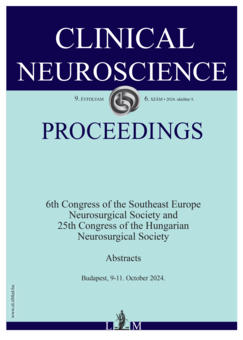The role of optical coherence tomography imaging in neurointervention
MAROSFŐI Miklós1
2024. OKTÓBER 09.
Ideggyógyászati Szemle Proceedings - 2024;9(6)
MAROSFŐI Miklós1
2024. OKTÓBER 09.
Ideggyógyászati Szemle Proceedings - 2024;9(6)
Szöveg nagyítása:

Optical Coherence Tomography (OCT) has emerged as a transformative imaging modality, offering high-resolution, cross-sectional imaging of tissue microstructure. Diagnosis of cerebrovascular disease involves a range of vascular neuroimaging techniques, including computed tomography (CT) angiography, magnetic resonance (MR) angiography (with or without contrast agents), and catheter digital subtraction angiography (DSA). These modalities primarily focus on providing information about the vessel lumen. Currently available OCT systems face challenges in being used routine within the intracranial circulation due to vessel caliber and tortuosity. Current endovascular treatments for brain vessel pathologies rely on image guidance with limited resolution, hindering thorough assessment of underlying arterial conditions and therapeutic devices. High-resolution imaging capable of visualizing cerebral artery microstructure and neurovascular device features could revolutionize cerebrovascular disease research, diagnosis, and treatment. The neurovascular high-frequency optical coherence tomography (HF-OCT) system, designed to rapidly capture volumetric microscopy data with resolutions nearing 10 microns in tortuous cerebrovascular anatomies. The potential of HF-OCT for cerebrovascular imaging was evaluated and demonstrated through multiple in vitro, ex vivo, and in vivo models.
Ideggyógyászati Szemle Proceedings
Despite evidence based institutional protocols being in place in many countries, aneurysmal subarachnoid hemorrhage (SAH) continues to be a major socio-economic burden with many open questions remaining regarding the optimal management of the affected patients.
Ideggyógyászati Szemle Proceedings
Arteriovenous malformation (AVM) is an anomaly of blood vessel formation. Numerous models have been established to understand the nature of AVM.
Ideggyógyászati Szemle Proceedings
Additive manufacturing has gained significant traction in industrial applications due to its high potential when it comes to manufacturing objects with complex geometry.
Ideggyógyászati Szemle Proceedings
Not only other surgical and robotic fields, but minimally invasive procedures in spine surgery have undergone significant development in recent times. A demand emerged from both surgeons and patients to develop and perform these types of surgeries in order to prevent biomechanical and surgical complications.
Ideggyógyászati Szemle Proceedings
Functional magnetic resonance imaging (fMRI) is crucial for presurgical language mapping in neurosurgery, helping identify eloquent brain regions to preserve during operations. Effective language mapping depends on advanced fMRI acquisition and detailed data analysis to ensure accurate clinical outcomes.
Ideggyógyászati Szemle Proceedings
A Magyar Neuroimmunológiai Társaság X. Kongresszusa Absztraktfüzet Siófok, Magyarország 2023. október 26–28.
Ideggyógyászati Szemle Proceedings
Functional magnetic resonance imaging (fMRI) is crucial for presurgical language mapping in neurosurgery, helping identify eloquent brain regions to preserve during operations. Effective language mapping depends on advanced fMRI acquisition and detailed data analysis to ensure accurate clinical outcomes.
Ideggyógyászati Szemle Proceedings
Tumors in and around brain stem remain one of the biggest neurosurgical challenges due to com- plex anatomy of this “high valued real estate area.
Ideggyógyászati Szemle Proceedings
N,N-Dimethyltryptamine is a natural hallucinogen, the active ingredient of the brew called ayahuasca consumed by Amazonian tribes for spiritual purposes.
Ideggyógyászati Szemle Proceedings
Since the initial implementation of deep brain stimulation (DBS) for essential tremor by Pollack and Benabid, it has emerged as the gold standard treatment over the past three decades. However, achieving successful outcomes still relies heavily on accurate planning and electrophysiological mapping of the Vim(ventral intermediate nucleus of thalamus).
A vérzéses transzformáció kockázatának meghatározása akut ischaemiás agyérbetegségben: Az ADC-értékek és a GRE hemoszekvencia-mikrovérzés összefüggése
Kognitív károsodás hosszú Covid esetén
1.
2.
3.
4.
5.
Egészségpolitika
Hadiállapotként kezeli és így is reagál a kormány az egészségügy „rendezésére”1.
2.
3.
4.
5.